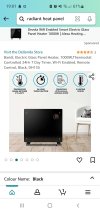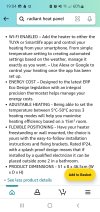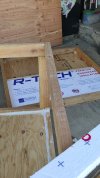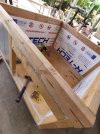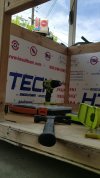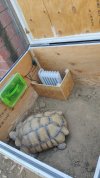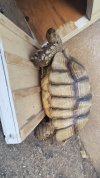Looks great. I have to get this done asap.I like my larger tortoises to live outside full time. My climate permits this year round with a little help. For people who live where it snows all winter, this type of box is still good for warmer weather, getting them out earlier in Spring, and keeping them out a bit later into fall. You'll need something else for the dead of winter. Or you can move South!
The top of this box is half a sheet of plywood, insulated and sealed, so 4x4 feet. The inside of the box ends up being around 40x40 inches when its all done. I use an 18x28 inch Kane heat mat on the floor, and a 21" radiant heat panel on the top. Both are controlled by the same thermostat: https://www.lllreptile.com/products/13883-zilla-1000-watt-temperature-controller
I lower the RHP so that it is within 6-8 inches of the tortoises carapace that lives in the box. I like to screw a plastic shoe box to the back of the box to contain all the extra wires and thermostat. Weather strip seals the top where the hinged lid meets it, and I use plastic freezer stripping across the door to hold in heat when the door is open. The door drops down like a drawbridge and makes a ramp fro the tortoise to get in and out easier. I latch the door shut every night and open the door every morning.
In summer our daytime highs are usually right around 100, with night time lows around 65. I unplug the boxes during this time and temps stay between 70 and 90 in them. In Fall, we have warm sunny days usually into December, so I set the thermostat to 80. As soon as the weather turns cold in winter, I bump the thermostat up to 86, so they always have an area to get warmer in on a cold rainy day here. Spring time brings back warmer sunny days, so I lower the box temp back down to 80. This routine works great for any tropical species like Stars, radiata, sulcatas and leopards.
Here is the box during construction. I frame the plywood walls with 2x4s and use 1.5" rigid foam as insulation. Then I seal it with silicone caulking and cover the walls with plywood inside.
View attachment 291639
Here is all the electrical stuff going into it:
View attachment 291640
View attachment 291641
Here I want to show the weather stripping in place, and the drip loop. The drip loop is simply draping the cord down a bit so that when it rains, the water drips down the cord to the ground instead of following the cord downhill right into the box.
View attachment 291642
Ready to keep a tortoise warm and safe at night:
View attachment 291643
This is a great way to house a large leopard or sulcata in a relatively warm climate. We get cold winter nights in the 20s and this box, built and heated this way, keeps them in the 80s. Because my climate is so dry, I usually add a 5 gallon bucket or some tubs of water to generate some ambient humidity inside the box. People in the South East US wouldn't need to do this.
Questions and conversation are welcome!
For larger tortoises, multiple tortoises, and a different heating strategy, see this thread:
Double Door Night Box
As the years have gone by and I build more of these boxes, I learn more and more each time. This one is the latest and I incorporated everything I've learned over the years. I also tried to take lots of pics so I can explain in more detail some of what is going on. It will take multiple posts to...tortoiseforum.org
Thank you so much and I might ask more questions now and then if you don't mind.
